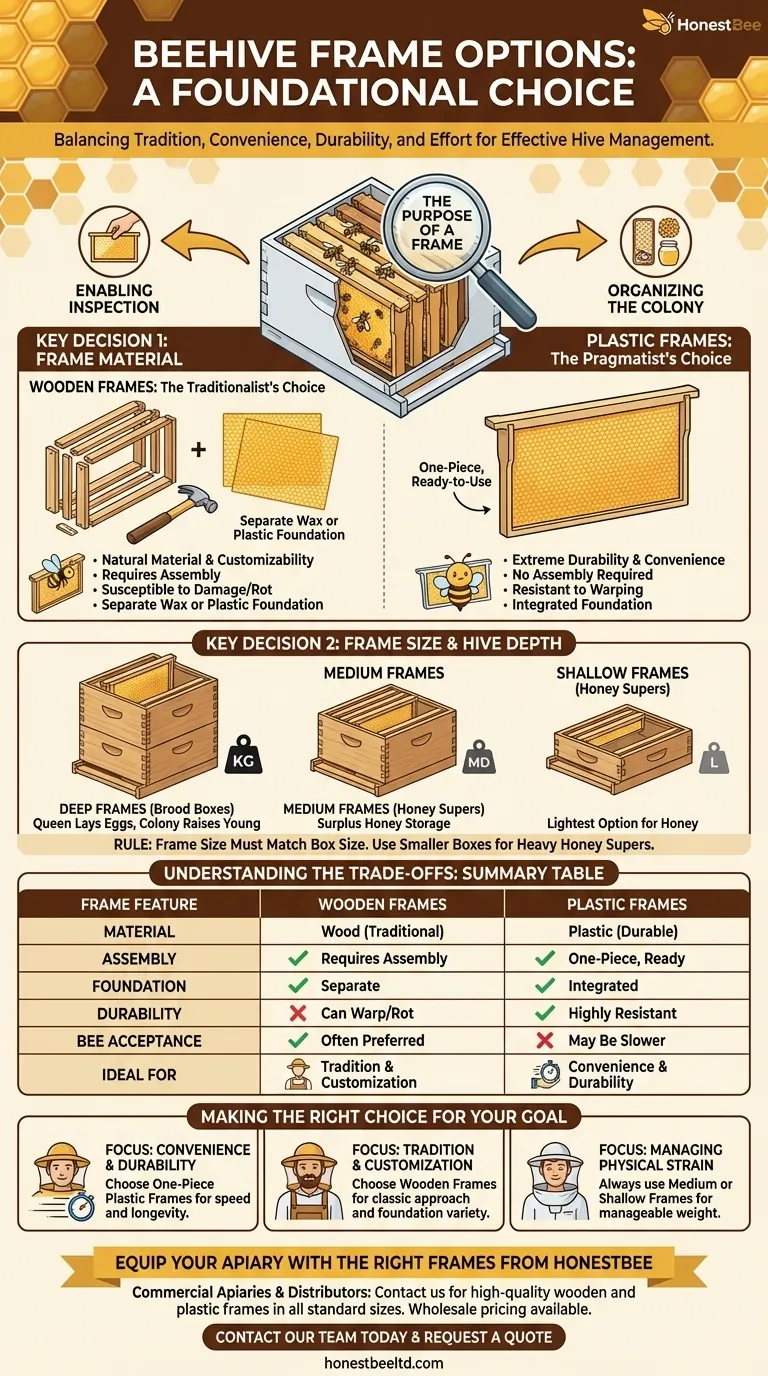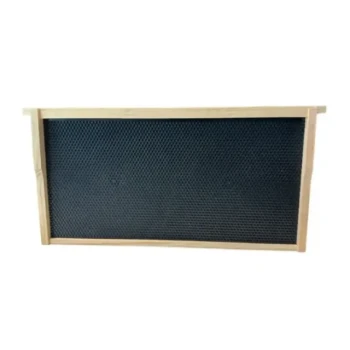At its core, a beehive frame is a simple structure that gives bees a foundation to build their comb. Your primary options are defined by two key factors: the material they are made from—either wood or plastic—and their size, which must correspond to the depth of your hive boxes.
The choice of a beehive frame is not an isolated decision. It is a foundational choice that impacts your hive management style, balancing the trade-offs between tradition, convenience, durability, and the physical effort required to manage your bees.

The Purpose of a Frame
Before comparing options, it's crucial to understand a frame's role. A modern beehive is a system of boxes filled with removable frames.
Enabling Hive Inspection
Frames provide a neat, orderly structure for bees to build their honeycomb. This allows you, the beekeeper, to remove and inspect individual sections of the hive without destroying the delicate comb structure.
Organizing the Colony
This removability is essential for managing the colony's health, checking on the queen, and harvesting honey. Frames are arranged strategically, with brood (developing bees) in the center and food stores (honey and pollen) on the outer edges.
Key Decision 1: Frame Material
The most fundamental choice you will make is between traditional wood and modern plastic frames.
Wooden Frames
Wooden frames are the classic, most common choice. They typically consist of four separate wood pieces that you assemble yourself, although pre-assembled options are available.
With wood, you must also add a foundation—a thin sheet of wax or plastic with a honeycomb pattern embossed on it—which the bees use as a guide to build straight comb.
Plastic Frames
Plastic frames are a durable, convenient alternative. Most are sold as a single, molded piece that includes the frame and foundation in one unit.
They require no assembly and are resistant to warping. Many beekeepers find them easier and faster to get into a hive.
Key Decision 2: Frame Size
Frames come in different heights to fit the standard depths of hive boxes. Using the wrong size frame for your box will create problems for you and your bees.
Matching Frames to Boxes
The rule is simple: the frame size must match the box size. A hive is typically made of a stack of boxes, and not all boxes are the same depth.
Deep, Medium, and Shallow
There are three standard depths:
- Deep Frames: Used in the large "brood boxes" where the queen lays her eggs and the colony raises its young.
- Medium Frames: Often used for "honey supers," the boxes stacked on top where bees store surplus honey.
- Shallow Frames: Also used for honey supers, these are the lightest option when full of honey.
The primary reason for using smaller medium or shallow boxes for honey is weight. A deep box full of honey can be extremely heavy and difficult to lift.
Understanding the Trade-offs
Neither wood nor plastic is universally superior; the right choice depends on your priorities.
Wood: The Traditionalist's Choice
The upside of wood is its natural material and customizability. You can choose different types of foundation (like pure beeswax) and some beekeepers believe bees take to it more readily.
The downside is the need for assembly, which can be time-consuming. Wooden frames are also more susceptible to damage from hive tools and can rot if not maintained.
Plastic: The Pragmatist's Choice
The upside of one-piece plastic frames is their extreme durability and convenience. They are ready to use out of the box, are less likely to break, and can be cleaned more aggressively.
The downside is that some beekeepers report their bees are slower to build comb on plastic. Furthermore, you cannot swap out the foundation style as you can with wood.
Making the Right Choice for Your Goal
Your decision should be guided by your beekeeping philosophy and practical considerations.
- If your primary focus is convenience and durability: One-piece plastic frames are the fastest way to get started and will withstand years of use.
- If your primary focus is tradition and customization: Wooden frames offer a classic approach and allow you to experiment with different foundation types.
- If your primary focus is managing physical strain: Always use medium or shallow frames for your honey supers, regardless of material, to keep them a manageable weight.
Ultimately, understanding how these components function as a system empowers you to build a hive that works best for you and your bees.
Summary Table:
| Frame Feature | Wooden Frames | Plastic Frames |
|---|---|---|
| Material | Traditional wood | Durable, molded plastic |
| Assembly | Requires assembly (parts or pre-built) | One-piece, ready to use |
| Foundation | Separate wax/plastic sheet added | Integrated into the frame |
| Durability | Can warp or rot over time | Highly resistant to damage |
| Bee Acceptance | Often preferred by bees | May be slower to adopt |
| Ideal For | Beekeepers valuing tradition & customization | Beekeepers prioritizing convenience & durability |
Equip Your Apiary with the Right Frames from HONESTBEE
Choosing the correct frames is crucial for efficient hive management and honey production. Whether you're a commercial apiary focused on scalability or a distributor supplying the beekeeping community, HONESTBEE provides the durable, high-quality frames you need.
We supply a full range of wooden and plastic beehive frames in deep, medium, and shallow sizes, designed to withstand rigorous use and optimize your operations. Our wholesale-focused model ensures you get reliable equipment at competitive prices, supporting your business's growth and success.
Let's discuss your frame needs and how we can support your beekeeping goals. Contact our team today to request a quote or learn more about our product catalog!
Visual Guide

Related Products
- Assembled Wooden Bee Frames with Plastic Foundation for Durability and Convenience by HONESTBEE
- Plastic Bee Frame Beekeeping Hive Frames for Wholesale
- Assembled Wooden Bee Frames with Beeswax Foundation Ready to Use by HONESTBEE
- HONESTBEE Wired and Assembled Wooden Bee Frames Foundation for a Thriving Hive
- Heavy-Duty Stainless Steel Clip-On Frame Perch
People Also Ask
- What materials are used to make beehive frames? Wood vs. Plastic for Your Apiary
- What materials are commonly used for beehive frames? Wood vs. Plastic for Your Apiary
- Can old bee frames be reused? Weighing the Risks vs. Rewards for Your Hive
- What are the main considerations when choosing between wooden and plastic bee hive frames? Optimize Your Apiary's Efficiency
- Can beekeepers switch between wooden and plastic frames? Optimize Your Hive's Performance



















